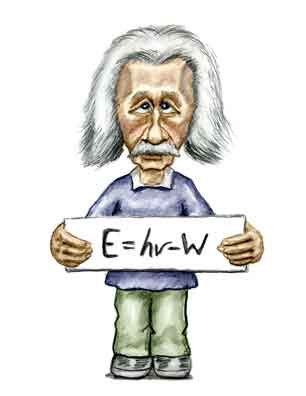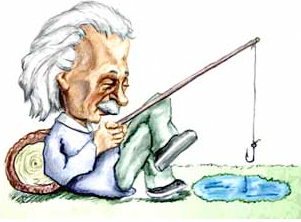Albert Einstein
1879 - 1955
E = WHAT?????!!!!!!

Albert Einstein
It wasn't just relativity.
E = hv - W.
That's pronounced "ee equals aitch-noo minus double- you".
But yes, yes, we know Albert also said E=mc2. That's his most famous equation. It explains why if you take enough hydrogen atoms - 1H to be exact - to weigh 4.0313 pounds plus throw in a half again as many beta particles (which weigh close to nothing), you only get 4.0026 pounds of Helium-4 (4He). What happened to the other 0.0287 pounds?
Well, we know it went to energy. About 27963875959 kilocalories (the calories they talk about in your food). Or another way to think of it is that it's enough energy to boil away 57 tons of water. This is the same reaction which allows us to bask in the warm sun as well - quote - "enjoy" - unquote - the less pleasant application of the H-bomb (before the nuclear chemists and physicists jump down and say, hold on, now, that's not exactly what happens in an H-bomb, CooperToons will say it knows that's not exactly what happens in an H-bomb). Now E=mc2 also applies to the atomic - or fission - bomb (which uses uranium or plutonium) but a lot of its power is electrostatic. Since it takes an incredible amount of energy to bring 92 protons together in one U-235 nucleus, breaking it apart into krypton and barium by hitting the atom with a neutron also releases energy. So as Robert Seber pointed out to the new recruits at Los Alamos, the explosion of an A-bomb is actually a non-relativistic phenomenon.
But what's this "ee equals aitch-noo minus double-you" business? Well, that was - for Albert - probably even more important than E=mc2. E=mc2 is made him famous. E = h v - W got him a Nobel Prize.
Or rather, it made it easier for the Nobel Committee to give him the Prize which said the award was granted "for his services to Theoretical Physics, and especially for his discovery of the law of the photoelectric effect." Now you can argue this citation is broad and also includes relativity. But realtivity is not mentioned and the "especially for" citation is clearly for the photoelectric effect.
The problem was even at that late date (1922, although the award was technically for 1921), the theories of relativity were still considered 1) a bit too theoretical (as late as 1928 some physicists were still talking about the "ether") and 2) not easily seen as benefiting mankind. The photoelectric effect, however, was immediately seen as a practical invention (although Albert didn't discover it). Another option would have been to cite Albert's explanation of Brownian motion (put pollen on a microscope slide and you'll see them bounce around by being hit by molecules). Important? Yes, before then atoms and molecules were considered even by a number of scientists to be mental conveniences. Browning motion was the first observable phenomenon to show that molecules were real.
So the Committee opted for citing the photoelectric effect. Shine light on metals and electrons come off. This is the basis for getting electricity from sunlight (although now most solar cells are silicon based). What E = hv - W means is the energy of the electrons shot from the metal surface can be calculated from the frequency of light (v) multiplied by a constant (the h, called Planck's constant) minus another constant, W. W is called the work function and is characteristic of the metal. This means you need to overcome some threshold value to get electrons by shining light on metal.
But don't worry. The Nobel Prize committee knew darn well they were giving Albert the Prize for relativity. In fact, that's what Albert talked about in his own Nobel Lecture. And although it took longer, relativity has been shown to be quite useful. Get in your car and set your destination on your GPS unit. The reason your directions will be so close - within 10 - 20 yards on a good system - is the GPS makes a small but needed correction based on Einstein's theories of relativity.
Albert was by no means an unworldly genius but a very worldly one. He liked the ladies (a contributing factor leading to his divorce with his first wife Mileva) and when offered a job at Caltech for $3000 a year he turned it down for the $15,000 a year pay at the Institute for Advanced Studies in Princeton. (Despite common misconception, the IAS is not officially connected with Princeton University). As an indication of the purchasing power of Albert's salary, the University of Oklahoma football coach Bud Wilkinson didn't get that until the late 1940's - and that was more than the university president made.
Some people have said after 1916, Albert might just have gone fishing for the rest of his life. Maybe. He spent most of his time working on the "Unified Field Theory" where gravity and electromagnetism would be packaged in one simple (or not so simple) theory. Although he announced he found it once (1929), he was wrong. So yes, even Albert made mistakes. That was equally evident by his handling his $24,000 Nobel Prize money. Like people today, Albert thought it would be nice to make even more money by doing nothing at all. So - again like people today - he invested most of it in the US stock market. It grew in value until it vanished in the crash of 1929.

Albert Einstein
After 1916.